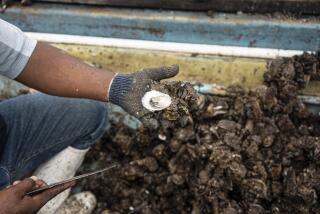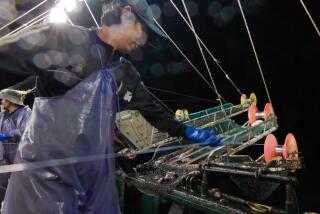Government Report on Seafood Safety Gets Industry Off the Hook : Critics Assail GAO’s Study as Incomplete
- Share via
While expressing concerns about the safety of seafood, a congressional study nevertheless found no compelling reason to greatly expand regulation of the fishing industry.
The General Accounting Office, the research arm of Congress, recently released its 77-page report, “Seafood Safety: Seriousness of Problems and Efforts to Protect Consumers.”
The study, begun in 1986, reviewed the overall risk from chemical contamination, viral agents, bacterial threats and parasites found in fish and shellfish. In addition to reviewing the latest research on the subject, the GAO also interviewed more than 350 federal and state officials involved in overseeing the nation’s seafood supplies.
Major Points
Among the study’s conclusions:
--The present rate of illnesses caused by seafood consumption does not constitute a widespread problem.
--Federal and state agencies do monitor, although on a limited basis, for contaminated fish and shellfish products.
--The more serious problems facing the industry--pollution and the health risks associated with raw seafood consumption--would not be solved by an intensified inspection program.
The findings--though criticized in some quarters--are a boost for the industry that has endured repeated attacks on seafood’s wholesomeness by Congress and a number of consumer groups.
Many critics also have called for a mandatory federal inspection program for seafood. Any such plan would resemble, to some degree, those in place for poultry and red meats where virtually every carcass is viewed by federal agents.
“We thought it was a pretty fair report,” said Lee Weddig, executive vice president of the National Fisheries Institute, a trade group. “It verifies the industry position that no (inspection) situation like those for meat and poultry is warranted at this time.”
According to the study, federal oversight of the seafood industry is a far cry from those for livestock and poultry.
For instance, only 1% of the nation’s catch is tested by the U.S. Food and Drug Administration for contamination, while 3% of all imports are similarly scrutinized. An additional 10% of the domestic supply is examined under a less thorough, voluntary program of the National Marine Fisheries Service.
Number of Cases
As for the number of illnesses, data from the Centers for Disease Control indicate that about 5% of food-poisoning cases between 1978 and 1984 could be traced to fish and shellfish. However, seafood consumption has risen to record levels since that period, or from 13.4 pounds per person in 1978 to 15.4 pounds in 1987. And some consumer groups claim that the illness rate is also increasing, but at a faster pace.
“The data . . . showed that most of the seafood-borne illnesses were associated with three species groups. Two groups include finfish that can generate biological toxins--ciguatoxin or scombrotoxin--capable of causing acute illness. The third group, representing about 53% of seafood illness cases, was molluskan shellfish that can accumulate high levels of disease-causing agents, or pathogens,” GAO reported.
A substantial portion of the report dealt with the continuing viral and bacterial contamination of shellfish, particularly clams, oysters and mussels.
“Major problems continue with shellfish sanitation in the United States,” the GAO said. “When contaminated mollusks are eaten raw or undercooked, they may inflict humans with vibrio cholerae, hepatitis, or other serious illnesses, which in some cases may become chronic or fatal.”
Of particular concern, according to the study, are the increasing incidents of illegal shellfish harvesting from unclean waters, the failure of states to monitor water quality where mollusks are concentrated and a lack of regular laboratory testing to determine the extent of microbiological contamination in these products.
The study also stated that the threat posed by chemical contamination of seafood due to water pollution is unknown.
“Fish and shellfish, particularly (mollusks), are exposed to an indeterminable number of chemicals and tend to concentrate these contaminants in their bodies at levels many times (those) existing in surrounding marine environment. While the presence of various types . . . of chemical contaminants (is) recognized, it is difficult to develop direct relationships between the . . . many chemical contaminants and human illness,” according to the GAO report.
For instance, a 1987 study said scientists do not know the human health risks from exposure to 90% of the chemicals that are found in the environment, the report stated.
Even so, FDA testing of seafood for chemical residues revealed that 3.6% of those samples analyzed were found to contain compounds at, or in excess of, allowable levels. The most common contaminant was polychlorinated biphenyls or PCBs, a carcinogen. As much as 25% of the imported seafood samples tested positive for chemical contamination, according to the GAO, with methyl-mercury--a toxin--the most common adulterant.
Although the report does not make specific recommendations to Congress, it does encourage improved testing for microbiological and chemical contamination of seafood--the areas of concern of those pressing for greater federal regulation.
The report, conducted for the House subcommittee on commerce, consumer and monetary affairs, has its critics.
“There were a number of perceived weaknesses in the federal agency (seafood) programs that GAO chose not to address in the report. It was disappointing,” said a subcommittee staffer who asked for anonymity.
Some of the areas overlooked in the formal report were incomplete statistics on the number of food-borne illnesses in this country, inconsistent contaminant testing procedures at FDA laboratories and underfunded enforcement programs, the staffer said.
Manipulation Charged
Ellen Haas, executive director of the Public Voice for Food and Health Policy, a Washington, D.C.-based consumer advocacy group, called the study incomplete and said the document’s authors manipulated statistics.
“(The report) does not look at chemical residues in seafood thoroughly and it strings out the data over a number of years. The report goes back to when seafood consumption was smaller than it is today,” said Haas, who has been a frequent critic of current inspection efforts.
Haas, who disputes the GAO’s illness statistics, claims there is cause for concern even if seafood accounts for only 5% of all food-borne illness.
“We eat four times as much chicken and beef as we do fish and it makes sense that (illnesses caused by seafood) would be smaller,” she said.
However, she said that seafood is responsible for about 24% of all food poisonings.
“The most recent figures,” she said, “demonstrate an unusually high incidence of food-borne illnesses that can be traced to seafood.”
Haas, whose group will continue calling for greater government regulation of fish and shellfish, also said: “Nowhere does GAO say there isn’t a problem. The report is just saying that it isn’t significant enough for legislation at this time.”
Weddig said that such concerns about seafood safety are pushed “way out of proportion.”
Yet Another Study
Even so, his group has been instrumental in launching yet another study of the nation’s seafood involving the FDA, the U.S. Department of Agriculture and the National Marine Fisheries Service. Results are expected in 18 months.
“We took the lead in saying to Congress that we need to find something better than the current system,” he said.
Another federal agency with responsibility for seafood safety is also considering proposing changes in the current system even before the joint-agency task force completes its work.
“There is a gathering interest in seafood inspection, and we are considering moving ahead with some kind of legislative proposal,” said Jim Brennan, assistant administrator for the National Oceanic and Atmospheric Administration in Washington.
“Generally speaking, most fishermen are providing a good product. But when there is a problem with bad shellfish, for instance, not only does it make people sick, it destroys confidence in those selling a good product,” he said.
More to Read
Sign up for Essential California
The most important California stories and recommendations in your inbox every morning.
You may occasionally receive promotional content from the Los Angeles Times.










